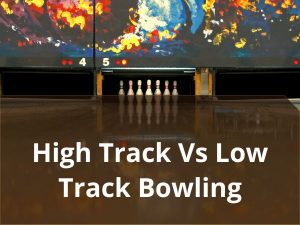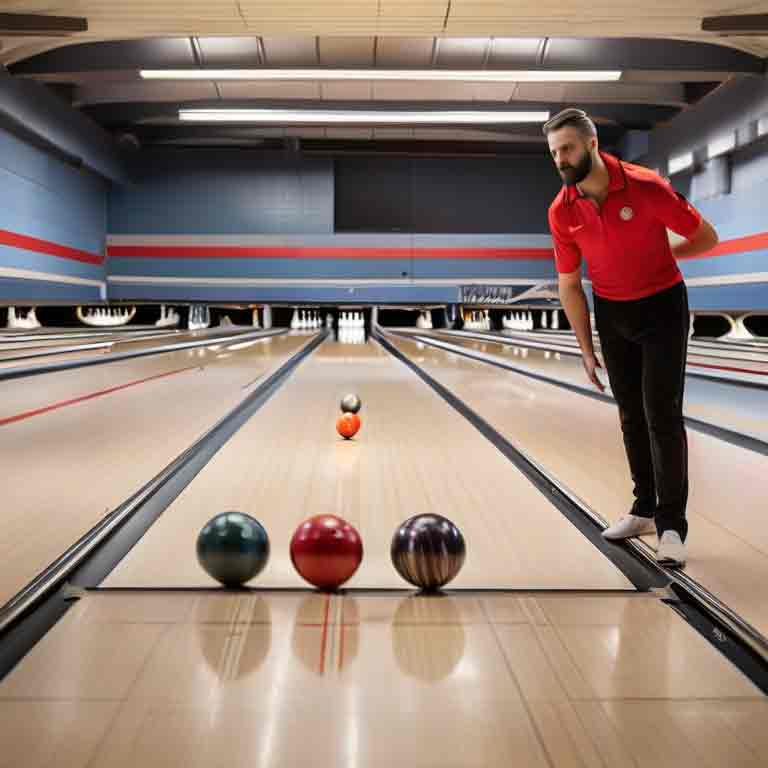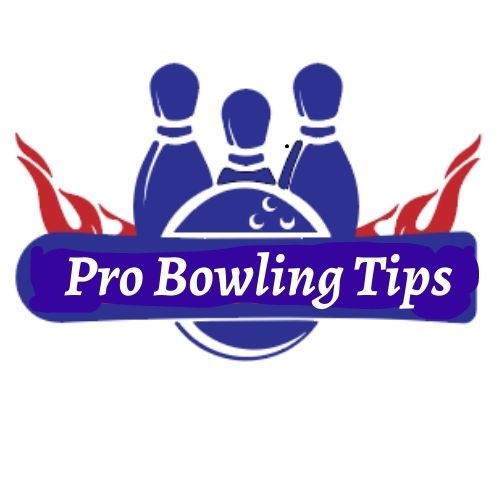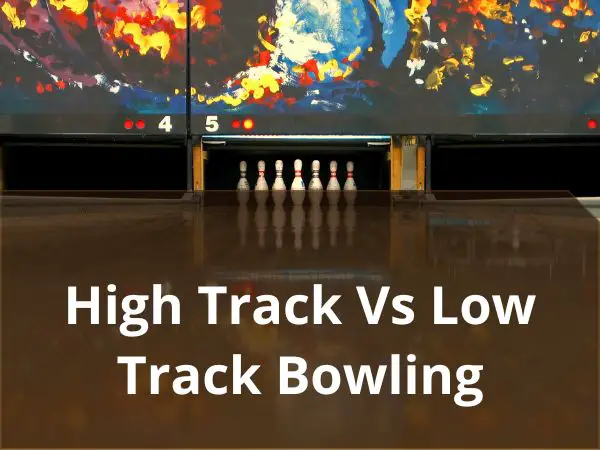High Track Vs Low Track Bowling! Are tournament and league seasons right around the corner? If you are a serious competitive bowler, I’m guessing, you’re busy practicing for your big day. While you’re at it, don’t forget to prep your bowling equipment as well. Getting your bowling ball ready for the battle includes drilling finger and thumb holes into it. And, before you do that, what is it you need first? The correct bowling ball layout. That’s right?
Do your research, study for it, and choose the most consistent layout according to how you track your bowling ball. This article here will describe what track is and differentiate between high track vs low track bowling. So if you’re interested to know more, give this a read to the end.

Comparison Table between High Track Bowling and Low Track Bowling
| Criteria | High Track Bowling | Low Track Bowling |
|---|---|---|
| Axis Tilt | Bowlers have low axis tilt | Bowlers have high axis tilt |
| Ball Motion | Strong, aggressive | Smooth, controlled |
| Hook Potential | High | Low |
| Rev Rate | High | Low |
| Lane Playability | Ideal for heavy oil conditions | Ideal for dry or light oil conditions |
| Lane Length | Shorter distance | Longer distance |
| Pin Carry | High pin carry due to strong ball motion | Less pin carry due to lower hook potential |
| Lane Transition | Requires frequent adjustments due to strong ball reaction | Requires less adjustment due to predictable ball motion |
| Skill Level | Suitable for advanced/professional bowlers | Suitable for beginners/intermediate bowlers |
| Ball Selection | Typically uses high-performance reactive resin balls | Typically uses entry-level or mid-performance balls |
| Scoring Potential | Higher scoring potential due to increased pin carry and hook potential | Lower scoring potential due to less pin carry and lower hook potential |
Note: The information provided in the table is general and may vary based on individual bowlers’ styles and preferences.
How to measure the oil track on a bowling ball?
Well, you can tell if you’re a high, medium, or low-track bowler just by looking at your oil ring on the ball. This is an important piece of information for your pro shop operator to have when determining the type of ball and drilling that suits your game. The relevance of the oil ring to your thumb and finger holes tells a lot about your style. So how close your track runs to your fingers and thumb holes? To understand what kind of track you have in your game, let’s learn more about high track and low track bowling, shall we?
I always get asked by new bowlers about what track is and what each type of track (high/low/medium) indicates. Well, first you need to understand that it is important to know what your ball roll looks like. So whether you’re a cranker, tweener, or stroker, you should also know if you’re a high-track or low-track bowler. And how do you measure that?

What is High Track Bowling?
Identification:
If you don’t know what is the level of your tracking, time to do some analysis. To know if you’re a high-track bowler or not, I want you to get the bowling ball you typically play with. Do you see any oil rings? How far is it from the thumb and finger holes? If the distance is about 1-1.5 inches, it is considered a high track. Generally, bowlers with less than 12° of initial axis tilt are called high-track bowlers.
Problem:
The problem with the high-track bowlers is that they have some limitations when it comes to choosing a layout for their bowling ball. If you’re a high-tracker and you randomly choose a layout that doesn’t fit you right, it will make the oil ring shift more towards the thumb and finger holes, and your ball will roll over these holes. Believe me when I say that will make your bowling really difficult. So what’s the solution for that?
Solution:
Simple! Go for the High Track Layout. If you take your ball to the nearby pro shop operator, they will first put the pin above and between the ring finger and the middle finger. Then they will take the CG about 2” right of the grip’s centerline. If needed, they will drill a balance hole into your bowling ball which will be 1” below the axis point.
It is an important fact to remember that a high track in bowling is measured by the track diameter instead of the track position. As I have just mentioned, a High track means you have a low axis tilt, and if your track is more on the higher side (a lot more than 12° tilt), your PAP will be much farther which will push the pin a bit away from the axis. As a result, a change in layout is often required. The benefit of being a high-track bowler is that you get to enjoy much stronger snaps on the backend.
Reasons behind high track bowling:
To understand the entire scenario clearly, I want you to picture a bowler who tracks very close to the thumb hole. This often leads to clipping the bevel. Because of the bowler’s high-track ball motion, he never gets his desired ball reaction. So, to solve the issue, the bowler attempted to change the pitch.
Yet, still no positive changes! So once he got his bowling style professionally checked he realized his track is off by 1/4″ and his dominant hand was outside his bowling ball the entire ball swing and follow-through.
Well, if the bowler kept his hand under and behind the ball for a bit longer, it would have made the ball release stronger. Once the player starts doing that, his track will move about an inch away from the drilled holes.
This is a major change in his bowling style. While it will lower his track, it will also decrease the axis rotation, and most importantly his thumb will get out of the thumb hole a bit earlier during ball releases without any disruption. This will dramatically change the ball reaction and will ensure much smoother ball throws.
What is Low Track Bowling?
Identification:
As you can guess, low-track bowling is quite the opposite of high-track bowling. If you didn’t know already— instead of the track position, the track in bowling is measured by the track diameter. For players who have a low track in bowling, the diameter is much smaller. In other words, the distance between the oil ring and the holes is pretty far. Bowlers with more than 18° of initial axis tilt are called low-track bowlers.
Pros of Low track bowling:
As many of you know, bowling balls with a low axis tilt (aka high track) burn up their energy faster after it gets in contact with a dry lane. Bowling with low track experiences the opposite situation. When bowling balls with a high axis tilt (which is considered low track) travel down the lane, they burn their energy much slower.
Because low-track bowlers see a less violent reaction down the lane, their bowling is much more consistent. A low-track bowler is more likely to have a high rotation that opens up the possibility of hooking his bowling ball more smoothly than any other track bowler.
Bowlers with low track can create a much stronger pin action on the lane, even though they have a weaker backend. If the aggressive breakpoint is not your cup of tea, you should opt for low-track bowling.
Difference between high track and low track bowling
The biggest difference between low track and high track bowling is that High track bowlers have a low axis tilt, and low track bowlers have a high axis tilt.
If you are a high-track bowler, you will see a much stronger snap on the backend. It is completely unlikely for low-track bowlers because their ball reaction at the breakpoint is not that violent. It is much more smooth and more consistent than high-track bowlers.
High-track bowlers get their bowling balls drilled in a high-track layout whereas low-track bowlers drill their bowling balls in a low-track layout.
The benefit high-track bowlers always get is their ability to make swift adjustments and even change their bowling style as per the lane condition. Low-track bowlers are more consistent in their shots which makes it harder for them to make changes whenever they can.
If a high track and a low track bowler compete against each other, you will see that the bowling ball of the low track bowler will rev over a certain area again and again. That wouldn’t be the case for a high-track bowler’s bowling ball. So why does this happen?
Well, a bowling ball with a high track rolls more aggressively. So that means, there is less friction. And because there isn’t too much friction, less oil gets picked up from the lane. Low-track bowlers see more oil on their bowling balls due to higher friction.
FAQs Of High Track Vs Low Track Bowling!
What determines high or low track in bowling?
- The track is determined by the ball’s revolutions and its proximity to the thumb and finger holes. High track has less axis tilt and spins closer to these holes, while low track has more tilt and spins further away.
Which is better for me?
- It depends on your bowling style, lane conditions, and personal preferences. High track offers aggressive hook and high scoring potential in oily conditions, suitable for advanced players. Low track offers more control and accuracy, better for dry conditions, and can be more suitable for beginners or those who prefer a more predictable ball motion.
How do I adjust my game for high or low track?
- For high track, focus on mastering the release and controlling the rev rate for a dynamic hook. For low track, practice rolling with reduced rev rates and adjust your grip for the best release point.
Conclusion
So, what’s your understanding of this article? Are you a high-track or a low-track bowler? I know the term ‘track’ is a bit confusing, but not impossible to understand. Here, I have explained everything as easily as I could. If you have any more questions, get in touch with me through the comment box down below.
Remember that, just because your ball reaction is a bit off, doesn’t mean you’re a high-track bowler. It can happen because of a lot of reasons. The best thing to do would be to go see a bowling alley coach and solve this matter face to face. The expert will figure out your problem instantly and suggest solutions according to your needs. Until then, good luck keep on bowling!

Passionate Bowler and Bowling Enthusiast
Jess Pinelli is a dedicated bowling enthusiast with a deep love for the sport that spans over 6 years. With numerous strikes, spares, and a few gutter balls under hes belt, he has honed his skills on lanes across the country. Pinelli’s journey in the world of bowling has been a remarkable one, from casual weekend games with friends to competitive league play and even a few local tournaments.
Driven by her passion for the game, Pinelli decided to channel her expertise and knowledge into the digital realm, becoming a prolific author on this bowling website. She’s your go-to source for everything bowling-related, from mastering the perfect hook to choosing the right bowling ball and even navigating the world of bowling etiquette.
When she’s not busy writing informative articles or reviewing the latest bowling gear, you’ll likely find Pinellis at her favorite local bowling alley, helping newcomers improve their game or enjoying some friendly competition with fellow bowlers. She firmly believes that bowling is not just a game but a community, and she’s committed to fostering that sense of camaraderie both online and offline.




